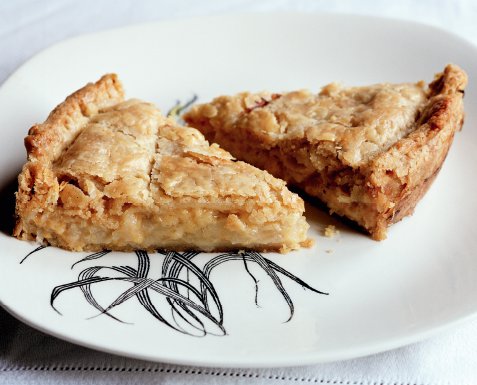Good Cook (5 page)
Authors: Simon Hopkinson

serves 4, with enough for seconds
1 small salted ox tongue, approx. 2¼ lb, well washed in cold running water for 5 minutes
2 carrots, peeled and cut in half lengthways
3 onions, one stuck with 4 cloves
4 sticks of celery, cut into short lengths
2 bay leaves
3 sprigs of thyme
a few peppercorns
for the horseradish and beetroot
3 medium-sized cooked beetroots, peeled and cut into chunks
3–4 tbsp horseradish base recipe (see
page 41
)
1 tbsp balsamic vinegar
1 level tbsp superfine sugar
salt, to taste
This relish is just fabulous with all boiled (perhaps poached is a more apt and delicate description) meats—and especially salted ones; and particularly good alongside boiled salt brisket, or even gammon or a bacon joint. I have, most successfully, poached tongue and brisket together before now, which makes for a hearty duet, it should be said. For some reason, the reaction between the beetroot and horseradish, once processed, is a powerful one, so please look out for your nose when you open the lid of the machine.
Put the tongue into a roomy pot and cover with water to a depth of about 2 in. Bring to the boil and remove any resultant scum as it forms on the surface. Now add the vegetables, herbs and peppercorns and simmer for about 2–2½ hours, or until the tongue is cooked; insert a skewer through the thickest part of the meat, and if there is no resistance, the tongue is done. Keep hot in the cooking liquor until ready to serve. (The vegetables may be discarded, as they have become exhausted and given up all their flavor to the broth.)
Meanwhile, make the horseradish and beetroot relish by blending all the ingredients together in a food processor until smooth-ish.
To serve, take the tongue from its liquor and remove the skin with a small knife. Slice the tongue and lay on a heated platter with, or without, some of its cooking liquor. Serve the beetroot and horseradish alongside. Creamed potatoes, or buttery boiled potatoes turned through some finely chopped parsley, are the order of the day here.
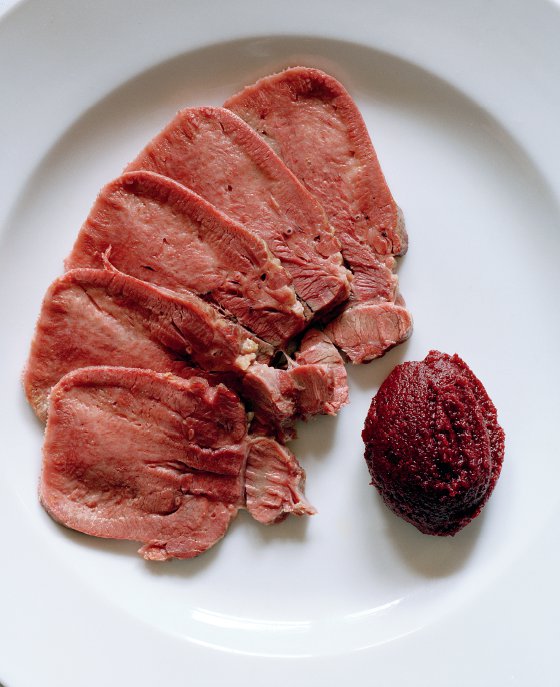
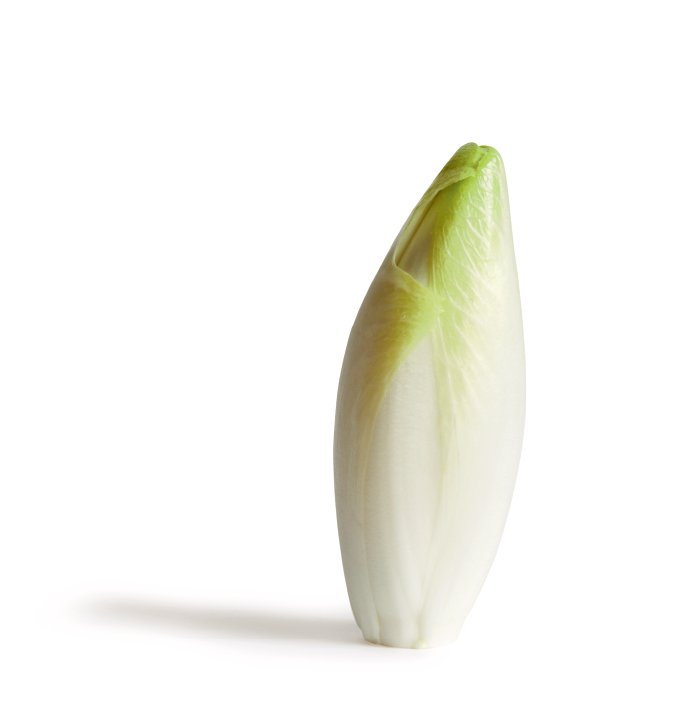
endive
serves 4 as a first course, or 2 for supper
4 tbsp butter
4 large endives, trimmed of any tired, outer leaves and the base core removed in a cone shape, using a small, sharp knife
salt and freshly ground black pepper
juice of 1 lemon
4 thin slices of cooked ham (smoked, if you like)
for the cheese sauce
2 tbsp butter
1 oz flour
1 cup cold milk from the fridge
1.1 oz grated Gruyère
1.4 oz grated Parmesan
salt, white pepper and a scraping of nutmeg
I am extremely fond of cooked endives. Or chicory, if you like, but as I was brought up as an apprentice in a French kitchen, it will always be endive with me, as it was the first place I saw them. The first thing that astonished me was the way they quietly cooked away without any added liquid apart from a splash of lemon juice. And what makes it even more curious is how lemon juice actually imparts a sweetness to the vegetable when it’s braised with butter. Naturally, however, when you consider that this firm little torpedo is, essentially, a tight bundle of salad leaves, the water content is bound to be high; the thing just oozes out its deliciously astringent juices into the pan as it putters away. Bitter, here, is good.
Preheat the oven to 325°F.
Use a solid-bottomed pot with a lid, making sure that it will take the endives in a single layer.
Melt the butter and cook until foaming. Put in the endives, turning them thoroughly in the butter, then season. Turn the heat down to low and gently color the endives on all sides until well glossed and golden. Add the lemon juice and turn up the heat a little. Cover, and place in the oven for 30 minutes.
Meanwhile, make the sauce. Melt the butter in a saucepan, stir in the flour, cook gently for a few minutes but keep the roux pale colored. Pour in the cold milk (this is important) all in one go, whisking together thoroughly, then place the pan over a very low heat, stirring constantly until beginning to thicken; although there should not be any, the odd lump that forms will, eventually, disappear into the sauce. Add all the Gruyère, 1 oz of the Parmesan, the seasonings, and allow to simmer very gently indeed, stirring occasionally, for about 10–15 minutes; slow cooking makes for a good cheese sauce—and all béchamel-based sauces, in fact. Cover, and keep warm.
Now, take the endives from the oven, remove the lid and turn them over. Cover once more and cook for a further 20–30 minutes or so; it is relatively difficult to overcook this delicious vegetable, and I quite like a braised endive to be a bit sticky and have crusted edges. If you too like this idea, then remove the lid for the last 10 minutes of cooking time. Furthermore, there is nothing worse than an endive that is firm in the middle. (Many recipes I read inform the cook that an endive can braise in 20 minutes. This is poppycock.) Increase the heat of the oven to 400°F.
To finish the dish, roll each endive in a slice of ham and lay in a lightly greased, shallow baking dish. Cover with the sauce and sprinkle over the remaining Parmesan. Cook on the top shelf of the oven for about 15–20 minutes, or until the sauce is bubbling around the edges and the surface is nicely blistered; flash under a hot broiler for a few seconds, if you like.
serves 3–4
1½ lb boned pork loins, rind removed
salt and freshly ground black pepper
a smear of lard, dripping or olive oil
a thick slice of butter
4 large endives, trimmed of any tired, outer leaves and the base core removed in a cone shape, using a small, sharp knife
2 shallots, chopped
10 oz dry cider
the merest splash of cider vinegar
3 sprigs of sage
2 cloves of garlic, bruised
There are two pale meats that have always been happy eating partners with the endive: veal is very good indeed, as is the following pork. However, when the chosen joint is cooked together with the endive as an ensemble, the marriage is one of the very best and most loved—at least it is, by this cook. The cider sweetens the dish in the most agreeable manner.
Preheat the oven to 325°F.
Season the pork loin and color in the lard, dripping or olive oil in a solid-bottomed pot over a moderate heat, until golden all over. Lift out the meat and put it on a plate. Add the butter to the pot and, when beginning to froth, introduce the endives and similarly color until they, too, are golden. Tip in the shallots and mingle them around a bit. Now push the endives to the sides of the pot and place the pork in the middle. Pour in the cider and add the vinegar, tuck in the sage sprigs and pop in the garlic cloves. Slide into the oven and cook, initially, for about 30 minutes. Remove the pot, turn over the pork, and cook for a further 30 minutes.
During this time, the cider will reduce somewhat, the endives will soften and, of course, the pork will cook. The hour should do it, but the liquid will probably still be a touch too thin. So, turn off the oven, remove the meat and endives (they should be very soft), keep warm in the oven’s waning heat with the door ajar, and place the
pot over a lively heat. Reduce the liquid until a touch more syrupy, but don’t overdo it; over-salty and over-sweet you don’t want.
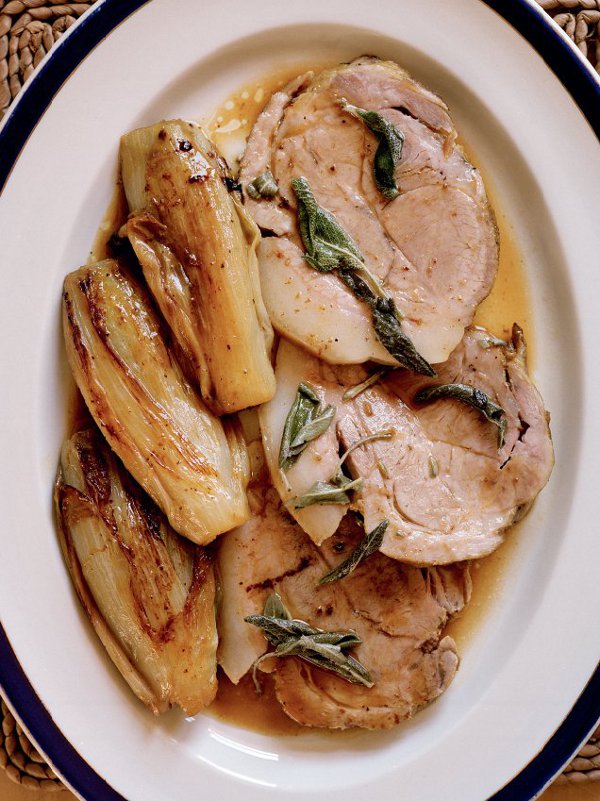
To serve, slice the pork on to a heated platter, garnish with the endives and spoon the sauce over—it must be said—this rather monotone assembly. However, be assured, it is a tasty dish with great charm.
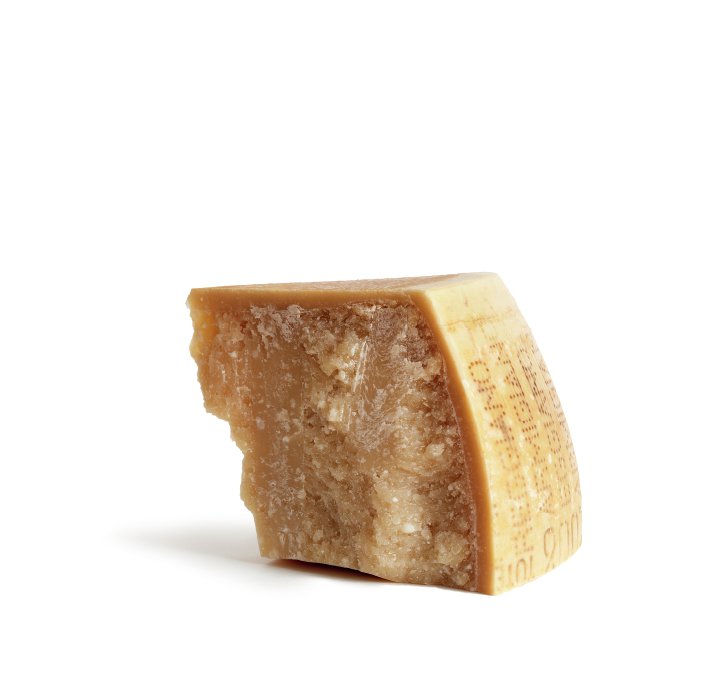
cheese
serves 4
for the pastry
4 tbsp butter
4 tbsp lard
1½ cups self-raising flour
pinch of salt
2–3 tbsp ice-cold water
for the filling
2 tbsp butter
3 onions, thinly sliced
1 teacupful of water
salt and plenty of freshly ground white pepper (it does not taste quite correct, using black)
9–10½ oz Lancashire cheese, coarsely grated
a little milk, to both seal and glaze the pastry
I have, in the past, written various recipes fashioned around this delicious pie, but I don’t think I have ever given the original. Here it is, adapted from her old and slightly battered recipe book, handwritten by Mother. This favorite is one among many others, some having been already handed down by
her
mother. Well, as it always was, in their day.
To make the pastry, cut the butter and lard into small chunks and place in a large bowl with the flour and salt. Gently rub the fat into the flour using fingertips until the texture resembles very coarse breadcrumbs. Mix in only just enough water to bind the mixture together. Lightly knead this dough until well combined, dust with flour and slip into a plastic bag. Place in the fridge for 30 minutes before using.
Preheat the oven to 350°F and also place a flat baking sheet in there, which will help to cook the base of the pie more evenly.
Meanwhile, prepare the filling. Melt the butter in a roomy pan and add the onions. Allow to quietly wilt and stew for about 10 minutes over a gentle heat without
coloring. Tip in the water and seasoning and continue to cook over a similar heat, stirring occasionally, until almost all the liquid has been driven off. Decant the onions on to a plate, spread them out and allow to cool.
Lightly butter a loose-bottomed tart tin (approx. 8 in wide x 1½ in deep). Roll out two-thirds of the pastry moderately thin and use it to line the base and sides of the tin. Now roll out the remainder to a similar thickness and also generously wide enough to use as a lid for the pie. Cover the base of the pie with half the onions and cover with half the grated cheese. Repeat.
Brush the edges of the pastry crust with milk to seal the pastry lid upon it, while also pressing the edges together lightly before trimming off any excess overhang. Brush the surface of the pie with milk. Make 3 small incisions into the center of the pie using the point of a sharp knife and, if you wish, further decorate the edges of the crust with the tines of a fork.
Put the pie on the preheated baking sheet and bake on the middle shelf of the oven for about 40–50 minutes, or until golden and with a clear indication that tiny oozes of cheese and onion juices are bubbling up through the holes in the middle. Remove from the oven and leave for a good 20–30 minutes before unmolding and cutting into generous wedges. Best served warm or at room temperature.
